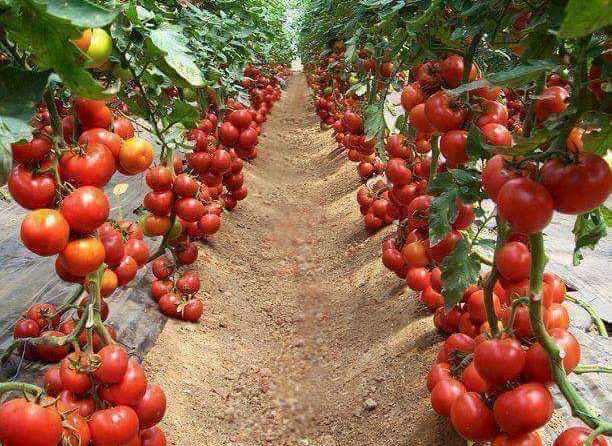- Tomato crop guide: Growing method Soil or soilless, protected crop (greenhouse or high plastic tunnel) or open field.
- Tomato crop guide: Soil type Tomatoes can be grown on soils with a wide range of textures, from light, sandy soils to heavy, clay soils. Sandy soils are preferable if early harvest is desired. Favorable pH level: 6.0-6.5. At higher or lower pH levels micronutrients become less available for plant uptake.
- Tomato crop guide: Climate Temperature is the primary factor influencing all stages of development of the plant: vegetative growth, flowering, fruit setting and fruit ripening. Growth requires temperatures between 10°C and 30°C.
| Growth stage | Temperature (0C) | ||
| Minimum | Maximum | Optimal | |
| Germination | 11 | 34 | 16-29 |
| Vegetative growth | 18 | 32 | 21-24 |
| Fruit setting (night / day) | 10 / 18 | 20 / 30 | 13-18 / 19-24 |
| Formation of lycopene | 10 | 30 | 21-24 |
| Formation of carotene | 10 | 40 | 21-32 |
[/ultimate_info_table]
Light intensity is one of the major factors affecting the amounts of sugars produced in leaves during the photosynthesis, and this, in turn, affects the number of fruits that the plant can support, and the total yield.
- Tomato crop guide: Irrigation
Tomato plants are fairly resistant to moderate drought. However, proper management is essential to assure high yield and quality.The water requirement of outdoor grown tomatoes varies between 4000 – 6000 m³/ha. In greenhouses up to 10,000 m3/ha of water are required. 70% or more of the root system are in the upper 20 cm of the soil. Therefore, a drip system equipped with a fertigation device is advisable.On light soils or when saline water is used, it is necessary to increase water quantities by 20% – 30%. Water requirements will differ at various growth stages. The requirement increases from germination until beginning of fruit setting, reaching a peak during fruit development and then decreasing during ripening.Mild water stress during fruit development and ripening has a positive effect on fruit quality: firmness, taste and shelf-life quality, but may result in smaller fruit. Late irrigation, close to harvesting, may impair quality and induce rotting.Water shortage will lead to reduced growth in general and reduced uptake of calcium in particular. Calcium deficiency causes Blossom End Rot (BER) (see page 15). On the other hand, excessive irrigation will create anaerobic soil conditions and consequently cause root death, delayed flowering and fruit disorders.Acidic (low pH) irrigation water is undesirable, as it might lead to the dissolution of toxic elements in the soil (e.g. Al3+).
- Tomato crop guide: Specific sensitivities of the tomato plant
Sensitivity to soil-borne diseases
Tomatoes are prone to soil-borne diseases caused by fungi, viruses or bacteria. Therefore it is recommended to avoid growing tomatoes on plots that used for other sensitive crops (peppers, eggplants, Irish potatoes, sweet potatoes, cotton, soybeans and others) on recent years. A regime of 3-year rotation between small grains and tomatoes is recommended.
Sensitivity to salinity
Under saline conditions, sodium cations compete with the potassium cations for the roots uptake sites, and chloride competes for the uptake of nitrate-nitrogen and will impede plant development (Fig.2) and reduce yield.Figure 2: Inverse relationship between top dry weight and concentration of plant tissue chloride – the higher the chloride in the plant composition, the lower its dry weight.
| Top dry weight (g) |
|
| Cl (mg/g) |
[/ultimate_info_table]
Salinity will result in a potassium deficiency in the tomato plants, leading to a low fruit number per plant. Corrective measures under such conditions must include the following steps:
- Abundant application of potassium, as this specific cation can successfully compete with the sodium, and considerably reduce its uptake and the resulting negative effects. (Fig. 3)
- Abundant application of nitrate, as this specific anion successfully competes with chloride, and markedly reduces its uptake and adverse effects.
- Also, calcium helps suppressing the uptake of sodium. When sufficient calcium is available, the roots prefer uptake of potassium to sodium, and sodium uptake will be suppressed.
Figure 3: Multi-K® potassium nitrate reverses the adverse effects of salinity in greenhouse tomatoes
(Source: Satti et Al. 1994)
| Top dry weight (g) |
|
| Cl (mg/g) |
[/ultimate_info_table]
Salination of the nutrient solution markedly decreased dry weight of the plant, fruit size and plant height. The addition of 4 or 8 mM Multi-K® potassium nitrate to the salinized nutrient solution markedly increased EC values of the nutrient solution but reversed the said adverse effects caused by the NaCl. Several parameters were improved even over the control as a direct result of the treatment with Multi-K®, i.e., fruit size and plant height (Fig. 4).
Figure 4: The effect of salinity and Multi-K® potassium nitrate on vegetative parameters and fruit
size in ‘Pusa ruby’ greenhouse tomatoes.
Zinc improves tolerance to salt stress
Zinc nutrition in plants seems to play a major role in the resistance to salt in tomato and other species. Adequate zinc (Zn) nutritional status improves salt stress tolerance, possibly, by affecting the structural integrity and controlling the permeability of root cell membranes. Adequate Zn nutrition reduces excessive uptake of Na by roots in saline conditions.
Sensitivity to calcium deficiency
Tomatoes are highly sensitive to calcium deficiency, which is manifested in the Blossom-End Rot (BER) symptom on the fruits. Salinity conditions severely enhance BER intensity. Recently, it was found that manganese (Mn) serves as antioxidant in tomato fruit, hence its application to tomatoes grown under salinity can alleviate BER symptoms in the fruits. Special care must be taken to avoid growing conditions, which enhance BER phenomenon.
Water quality: Tomatoes tolerate brackish water up to conductivity of about 2-3 mmho/cm.
1. Tomato Crop Guide: Growth patterns
Tomato cultivars may be classified into three groups by their growth patterns, which are recognized by the arrangement and the frequency of leaves and the inflorescence on the stem.
- Indeterminate growth– the main and side stems continue their growth in a continuous pattern. The number of leaves between inflorescence is more or less constant, starting from a specific flowering set (Fig. 1a). Cultivars of indeterminate growth are usually grown as greenhouse or staked tomatoes.
- Determinate growth– the main and side stems stop growth after a specific number of inflorescences that varies with the specific cultivar (Fig. 1b). Processing tomatoes are often belong to determinate cultivars.
- Semi-determinate growth– branches stop growth with an inflorescence, but this usually occurs at an advanced growth stage. Cultivars of this group are usually grown as out-door, non-staked tomatoes.
| No. of leaves before inflorescence | ||
| Indeterminate | Determinate | |
| 1st inflorescence | 6-14 | 4-3 |
| 2nd inflorescence | 5-7 | 2-3 |
| 3rd and further inflorescences | 3-5 | 0-1 |
[/ultimate_info_table]
2. Tomato crop guide: Growth stages
Growth stages of plants, in very general terms, can be split into four periods:
- Establishment from planting or seeding during vegetative growth until first flower appears.
- From first flowering to first fruit set.
- From fruit ripening to first harvest.
- From first harvest to the end of last harvest.
These growth periods also represent different nutritional needs of the plant (see section 3.1).
The duration of each stage may vary according to growing method, variety characteristics and climatic conditions (Table 2).
| Variety | VF121 | |
| Growing method | Greenhouse | |
| Number days to first flowering | 30 | |
| Number days to first harvesting | 65 | |
| Growth stage | Stage duration (days) | Crop age (days) |
| Planting | 1 | 1 |
| Vegetative | 14 | 15 |
| First flowering | 15 | 30 |
| First fruit set | 10 | 40 |
| Fruit growth | 20 | 60 |
| Starting harvest – until end of last harvest | 21-145 | 81-210 |
[/ultimate_info_table]
3. Tomato crop guide: Fruit development
After fruit setting, fruit ripens over a period of 45 – 70 days, depending upon the cultivar, climate and growth conditions. The fruit continues growing until the stage of green ripeness.
Three fruit developmental stages are noted.
Ripening occurs as the fruit changes color from light green to off-white, pink, red, and finally dark red or orange. Depending on the distance and time to market, harvest may occur anytime between the pink to dark red stage, the later stages producing more flavorful fruit.
| Stage | Description |
| Breaker | Red stains appear on fruit skin |
| Pink | Tomato turns pink, not yet ready for consumption |
| Red | The tomato is red and completely ripe for consumption |
[/ultimate_info_table]
4. Tomato crop guide: Crop uses
Tomatoes are consumed fresh, and are being processed to pickles, sauce, juice and concentrated pastes.
Tomato crop guide: Fertilization recommendations
The recommendations appearing in this document should be regarded as a general guide only. The exact fertilization program should be determined according to the specific crop needs, soil and water conditions, cultivar, and the grower’s experience. For detailed recommendations, consult a local Alexa representative.
Disclaimer: Any use of the information given here is made at the reader’s sole risk. Alexa Enterprises Pvt. Ltd. provides no warranty whatsoever for neither “Error Free” data, nor does it warrants the results that may be obtained from use of the provided data, or as to the accuracy, reliability or content of any information provided here.
In no event will Alexa Enterprises Pvt. Ltd. or its employees be liable for any damage or punitive damages arising out of the use of or inability to use the data included.
Tomato crop guide: Dynamics of nutritional requirements
Nitrogen and potassium uptake is initially slow but rapidly increases during the flowering stages.
Potassium is peaking during fruit development, and nitrogen uptake occurs mainly after the formation of the first fruit. (Figs. 5 and 6).
Phosphorus (P) and secondary nutrients, Ca and Mg, are required at a relatively constant rate, throughout the life cycle of the tomato plant.
(Source: Huett, 1985)
Figure 5: The uptake dynamics of the macro- and the secondary nutrients by a tomato plant
| Uptake rate (g/plant) |
[/ultimate_info_table]
Figure 6: Daily uptake rates of plant nutrients by processing tomatoes yielding 127 T/ha
(Source: B. Bar-Yosef . Fertilization under drip irrigation)
| Uptake rate (kg/ha/day) |
|
| Days after planting |
[/ultimate_info_table]
As can be seen in figures 5 and 6, the greatest absorption of nutrients occurs in the first 8 to 14 weeks of growth, and another peak takes place after the first fruit removal. Therefore, the plant requires high nitrogen application early in the growing season with supplemental applications after the fruit initiation stage. Improved N use efficiency and greater yields are achieved when N is applied under polyethylene mulches via a drip irrigation system. At least 50 % of the total N should be applied as nitrate-nitrogen (NO3- ).
The most prevalent nutrient found in the developed tomato plant and fruit is potassium, followed by nitrogen (N) and calcium (Ca). (Figures 7 and 8)
Figure 7: Element composition of a tomato plant
(Atherton and Rudich, 1986)
Figure 8: Element composition of a tomato fruit
(Atherton and Rudich, 1986)
Tomato crop guide: Main functions of plant nutrients
| Nutrient | Functions |
| Nitrogen (N) | Synthesis of proteins (growth and yield). |
| Phosphorus (P) | Cellular division and formation of energetic structures. |
| Potassium (K) | Transport of sugars, stomata control, cofactor of many enzymes, reduces susceptibility to plant diseases. |
| Calcium (Ca) | A major building block in cell walls, and reduces susceptibility to diseases. |
| Sulphur (S) | Synthesis of essential amino acids cystin and methionine. |
| Magnesium (Mg) | Central part of chlorophyll molecule. |
[/ultimate_info_table][ultimate_info_table design_style=”design04″ color_scheme=”green” heading_font_size=”desktop:26px;” features_font_size=”desktop:16px;” css_info_tables=”.vc_custom_1580710424566{margin-bottom: 30px !important;}”]
| Magnesium (Mg) | Central part of chlorophyll molecule. |
| Iron (Fe) | Chlorophyll synthesis. |
| Manganese (Mn) | Necessary in the photosynthesis process. |
| Boron (B) | Formation of cell wall. Germination and elongation of pollen tube. Participates in the metabolism and transport of sugars. |
| Zinc (Zn) | Auxins synthesis. |
| Copper (Cu) | Influences in the metabolism of nitrogen and carbohydrates. |
| Molybdenum (Mo) | Component of nitrate-reductase and nitrogenase enzymes. |
[/ultimate_info_table][ultimate_info_table design_style=”design04″ color_scheme=”green” heading_font_size=”desktop:26px;” features_font_size=”desktop:16px;”]
| Nutrient | Functions |
| Nitrogen (N) | Synthesis of proteins (growth and yield). |
| Phosphorus (P) | Cellular division and formation of energetic structures. |
| Potassium (K) | Transport of sugars, stomata control, cofactor of many enzymes, reduces susceptibility to plant diseases. |
| Calcium (Ca) | A major building block in cell walls, and reduces susceptibility to diseases. |
| Sulphur (S) | Synthesis of essential amino acids cystin and methionine. |
| Magnesium (Mg) | Central part of chlorophyll molecule. |
| Iron (Fe) | Chlorophyll synthesis. |
| Manganese (Mn) | Necessary in the photosynthesis process. |
| Boron (B) | Formation of cell wall. Germination and elongation of pollen tube. Participates in the metabolism and transport of sugars. |
| Zinc (Zn) | Auxins synthesis. |
| Copper (Cu) | Influences in the metabolism of nitrogen and carbohydrates. |
| Molybdenum (Mo) | Component of nitrate-reductase and nitrogenase enzymes. |
[/ultimate_info_table]
Nitrogen (N)
The form in which N is supplied is of major importance in producing a successful tomato crop. The optimal ratio between ammonium and nitrate depends on growth stage and on the pH of the growing medium.
Plants grown in NH4+ -supplemented medium have a lower fresh weight and more stress signs than plants grown on NO3- only. By increasing the ammonium nitrate rates, the EC increases and consequently the yield decreases. However, when doubling the rate of Multi-K® potassium nitrate, the EC increases without adverse effect on the yield that increases as well
Table 6: The effect of nitrogen form (NO3- and NH4+) on tomato yield – showing the advantages of nitrate-nitrogen over ammonia cal nitrogen. (Source: U. Kafkafi et al. 1971)
| NO3– : NH4+ ratio |
N g/plant | EC (mmho/cm) |
Yield (kg/plant) |
|
| Multi-K potassium nitrate |
Ammonium Nitrate | |||
| 100 : – | 6.3 | – | 1.7 | 2.5 |
| 70 : 30 | 6.3 | 4.4 | 2.4 | 1.98 |
| 63 : 37 | 6.3 | 8.7 | 2.9 | 1.20 |
| 59 : 41 | 6.3 | 13.2 | 3.5 | 1.00 |
| 100 : – | 12.6 | – | 3.1 | 3.43 |
[/ultimate_info_table]
Potassium (K)
Ample amounts of potassium must be supplied to the crop in order to ensure optimal K levels in all major organs, mainly due to the key role K plays in tomatoes:
As a cation, K+ is THE dominant cation, balancing negative charges of organic and mineral anions. Therefore, high K concentration is required for this purpose in the cells.
-
Balancing of negative electrical charges in the plant
Main function is in activating enzymes – synthesis of protein, sugar, starch etc. (more than 60 enzymes rely on K). Also, stabilizing the pH in the cell at 7 – 8, passage through membranes, balancing protons during the photosynthesis process.
-
Regulating metabolic processes in cells
Regulating plant’s turgor, notably on guard cells of the stomata.
In the phloem, K contributes to osmotic pressure and by that transporting metabolic substances from the “source” to “sink” (from leaves to fruit and to nurture the roots). This K contribution increases the dry matter and the sugar content in the fruit as well as increasing the turgor of the fruits and consequently prolonging fruits’ shelf life.
Additionally, potassium has the following important physiological functions:
-
Regulation of osmotic pressure
- Improves wilting resistance.(Bewley and White ,1926, Adams et al ,1978)
- Enhances resistance toward bacterial viral, nematodes and fungal pathogens. (Potassium and Plant Health, Perrenoud, 1990).
- Reduces the occurrence of coloration disorders and blossom-end rot. (Winsor and Long, 1968)
- Increases solids content in the fruit. (Shafik and Winsor,1964)
- Improves taste. (Davis and Winsor, 1967)
Figure 9: The effect of K rate on the yield and quality of processing tomatoes
Lycopene is an important constituent in tomatoes, as it enhances the resistance against cancer.


